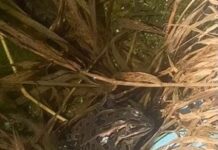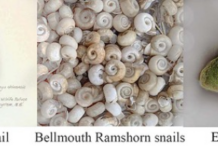by Fred Schueler, Fragile Inheritance Natural History
With the increased human population and intensification of agriculture, the North Grenville Environmental Advisory Committee is undertaking a study and evaluation of the flow of water through the Municipality, beginning with the municipal system in Kemptville.
The Report Cards that conservation authorities periodically issue for watersheds compare the concentration of plant nutrients – fixed nitrogen, phosphorus, and potassium – to provincial standards for these elements. These provincial standards are designed to prevent the overgrowth of algae and aquatic plants in eutrophic (“true-feeding”) conditions, in order to approach the natural oligotrophic (“low-feeding”) condition. In my undergraduate plant ecology course, we learned that mature plant communities make a net extraction of these nutrients from precipitation, and in 1989 (Trail & Landscape 23(3):122-125), I proposed that this net extraction be used as a criterion of environmental health.
Because of the influence of annual-based agriculture, we are accustomed to think of nutrients as belonging to the soil, but, in ecologically mature communities, a large percentage of the mineral nutrients are held in living organisms. The perennial root network holds and takes up nutrients as they become available in soil moisture or, in association with myccorhizal fungi, even takes them directly from the decay of fallen litter. These root webs are most active in tropical rainforests, but at all latitudes, fully developed communities are able to effect a net extraction of nutrients from rainfall.
This ability to extract nutrients from the ‘distilled’ water of precipitation is most spectacular where entire communities are ombrotrophic – feeding from the clouds – deriving their mineral nutrients solely from the minerals in rainwater. In most habitats, the rootless mosses and lichens are the only regular ombrotrophs. In bogs, fens, and the epiphytic communities on the branches of rainforest trees, the paucity of soil nutrients makes rooted plants dependent on nutrients from precipitation, and it is in these habitats that we see vascular plants with the most extreme adaptations for nutrient collection: the fungal symbionts of orchids and the nutrient traps of insectivorous plants.
The struggle for the greater nutrient resources of ordinary soil is just as intense. On most substrates, mature communities allow so little of the major nutrients past their root webs that they make a net removal of the fixed nitrogen that builds protein, the phosphorus that holds genetic information in nucleic acids and organic energy in adenosine triphosphate, and the potassium that balances sodium in the osmotic milieu of the cell. Since most of the outflow of nutrients is in drainage water, and the concentration of nutrients in river water and rain can easily be measured, the net flow of nutrients for the entire watershed can be expressed by a formula of percent retention (positive) or loss (negative) of the nutrients in precipitation.
Almost every sort of environmental degradation results in the loss of mineral nutrients, because of stress to the root-web, deaths of organisms, the disruption of soil, or the introduction of concentrated nutrients that cannot be used by plants. Processes other than water flow which tend to export nutrients are often economically favoured (agriculture) or actively combatted (wild fires), and nutrients may be sequestered in sediments in lakes or wetlands, or imported by migrating animals. On the whole, however, careless agriculture, soil erosion, paving of ground, clear-cutting, acidic precipitation, high concentrations (at least) of pesticides, and organic or inorganic water pollution all result in the release of nutrients into outflow water, and it may well be that this measure of environmental health will prove to measure the synergistic effects of a diversity of pollutants and stresses, since it measures the actual failure of the community to function as a whole.
Nutrient levels in streams have traditionally mostly been measured in the summer, but this could be done throughout the year, and compared with precipitation to calculate a drainage basin’s overall nutrient status. With the current provincial restrictions on the mandate of conservation authorities, and the central position of the river drainage in the Municipality, North Grenville could take the lead in recognizing this kind of environmental health by sampling the river at the Prescott Street bridge, and calculating the overall nutrient status of the watershed.
Fragile Inheritance Natural History: bckcdb@istar.ca









